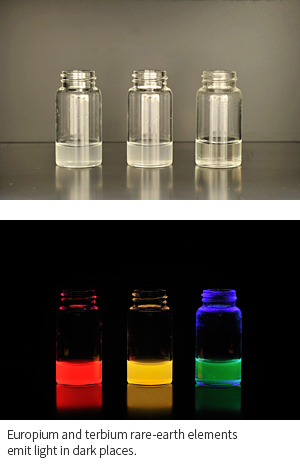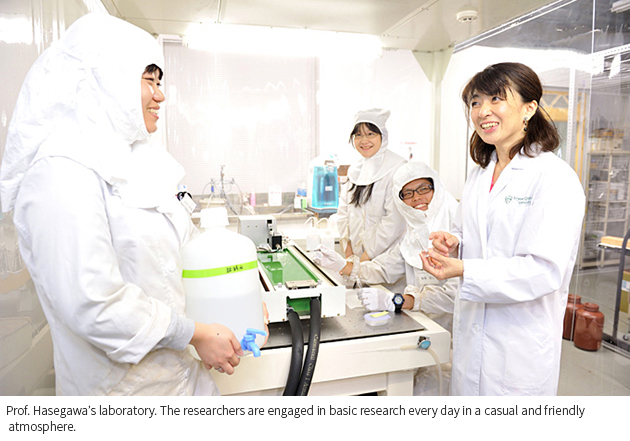At the College of Science and Engineering, science and engineering are seen as disciplines that complement each other in the pursuit of knowledge. Research conducted at the college is scientific research, which is included in the category of basic research. Basic research is focused, not on achieving something that can be applied or used immediately for a particular purpose, but on studying the mechanisms of nature and pursuing the essence and principles of things. The findings of basic research underpin great progress in the field of application.
Let us take “color” as an example. There are many colors around us. One of the colors that can often be seen in nature is green, the color of grass and leaves. But how can we perceive the green color of grass and trees? The main element of the green color is chlorophyll. Chlorophyll contained in leaves plays a central role in photosynthesis, a function indispensable for plants to maintain their lives. Chlorophyll absorbs only light with a particular energy from sunlight. The light that is not absorbed is reflected by the leaves, and we see this light and perceive it as green. The color of the light absorbed by plants and the color of the light reflected and caught by our eyes are complementary colors. In other words, the green color is the opposite color of the light absorbed by plants for their survival.
Then why does the color of leaves change according to the season? Chlorophyll and other proteins are decomposed when the temperature falls in autumn and winter and stop absorbing light that has been taken in efficiently until then. With the decomposition of chlorophyll progresses, carotenoids—pigments contained in leaves that are perceived by our eyes as yellow, which are normally hidden behind the green color of chlorophyll—are revealed without being decomposed because they can withstand the cold temperature. This is the mechanism that makes leaves look yellow. Leaves of some plants turn red, and this is said to be because pigments called anthocyanins are formed in leaves in autumn. When light in the green wavelength is absorbed by anthocyanins, leaves look red. Figuring out these fundamental mechanisms may allow us to use the color of leaves as a means of understanding information on proteins and other elements contained in trees.
In this way, all phenomena on the earth have their own meanings and reasons. The objective of basic research is to discover answers to the question of why and how the phenomena take place through dialogues with nature and connect them to the development of new materials and other applications.
Basic research ravels the questions of why and how phenomena on the earth take place through dialogues with nature, but what for? You may be wondering in what way basic research can be useful. It is true that the results of basic research usually do not lead to their commercialization immediately. However, the discovery of new principles of nature may provide the possibility of solving issues of modern society and changing people’s lives dramatically.
We are often hearing or seeing news mention rare metals on TV or in newspapers recently. Rare metals are indispensable elements in modern society, used in a wide variety of applications for functional materials, such as additives to improve the strength of alloy and increase the rust resistance of construction materials or as raw materials for light-emitting diodes, batteries, permanent magnets, and electronic components. However, although rare metals are already used in a broad range of ways, it is believed that there are still many untapped applications.
My research group has developed a material that causes a “special phenomenon” by combining praseodymium metal ion, which is one of rare-earth elements that form a part of rare metals, and a stearic acid soap molecule, and succeeded in elucidating the mechanism of the phenomenon for the first time in the world. The phenomenon is called “polarized light emission from molecules.”

As is widely known, light has wave-like properties. Light from the sun, electric bulbs, and other light sources vibrates like a wave as it travels in both vertical and horizontal directions. As opposed to this ordinary light, light for which vibrations occur only in a single direction is called “polarized light.” Like long sticks, which can be handled more easily when bundled in the same direction, polarized light can be—as you can imagine—controlled far more easily than ordinary light vibrating in random directions. Color liquid crystal displays (LCDs) are one example of devices that take advantage of polarized light. In current LCDs, light from backlighting is polarized through filters, meaning that they require both a backlight unit to emit light and filters to polarize light. However, the polarized light emitting film developed by us is capable of both emitting and polarizing light, making the production of LCDs much simpler. Since the film is also capable of generating two polarized light beams at the same time, it may be possible in the future that multiple images can be displayed concurrently on one screen. Because of these advantages, our basic research is attracting attention from both within and outside Japan.

The students in my laboratory say that they are often asked “How can your research be useful?” at job and other interviews. I advise them to answer in this way: “My laboratory aims at researching ‘eternal truths,’ rather than something that can be useful immediately. It is a type of research that can be conducted only at a university and can lead to the discovery of a principle for the design of new materials.” As a matter of fact, I myself have one ambition. It is to discover a principle that is so important that it will be introduced in school textbooks around the world, through research activities that I will continue until my retirement.
I conceived the idea, mentioned earlier, of developing a film of the soap molecule and praseodymium for polarized light emission more than 15 years ago. The idea rose to my mind when I was exploring a research theme that no one else had been undertaking, and when I started the research, I did not think at all about how the idea could be applied. However, when I published a paper in 2007, I received suggestions on application of the idea from experts in various fields, such as next-generation display, anti-peeking function for automated teller machines, etc., and anti-counterfeiting security ink for bank bills. All these application ideas, proposed one after another based on different perspectives of the experts, were something that I had never thought of.
In this way, the discovery of a new material and mechanism may lead to a new possibility that even the researcher has never imagined. This is where the real joy of basic research in science lies.
The new molecule, the details of which I published in January 2014, is a simple molecule with a helical structure, which emits beautiful light. This molecule is the result of my struggling for 10 years to discover this helical molecular design that meets the demand for a rare-earth molecule capable of emitting intensive light even in liquid solutions. Water and other solutions are also an assemblage of molecules, and the problem was that rare-earth molecules do not emit light amid the wobbling molecules of solutions. To overcome this problem, I redesigned the molecule to have a helical structure to create a new light-emitting molecule.
Japan has produced many Nobel Prize winners. One reason behind this is Japanese passion and persistence toward basic research. Japanese researchers have traditionally spent a great deal of time focusing on particular research. This kind of research culture, which may be comparable to craftsmen’s professionalism, has been passed down uninterruptedly. This research culture has been fostered at companies as well, as evidenced by the fact that the blue light-emitting diode, lithium-ion battery, carbon nanotube, and other many other high-quality research results have been produced by companies. We must pass along this Japanese research culture to next generations.
The problem of a declining number of young people interested in science is currently receiving attention. In my view, people’s brains have no distinction between science-oriented and humanities-oriented. I myself was actually humanities-oriented when in high school and, as a classical literature lover, planning to major in literature at university. But I came to know how much fun science is through an independent study project during a summer vacation, and this experience made me decide to enter the College of Science and Engineering at the Aoyama Gakuin University. This was the beginning of my career path as a chemist.
I feel that it is a waste of your talent if you decide your future path simply because you like or do not like science, mathematics, or other particular subject. More importantly, you should embrace your curiosity and desire to know what you do not know.
Imagine that a principle of nature that you have discovered may change the world completely. Don’t you think that this is exciting?

(This column is as of 2014.)